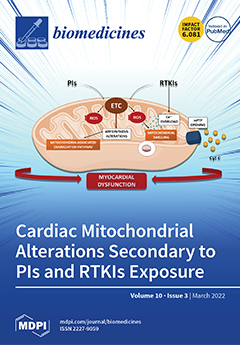Objectives: Periodontal disease (PD) and rheumatoid arthritis (RA) are known chronic conditions with sustained inflammation leading to osteolysis. Cardiovascular diseases (CVD) are frequent comorbidities that may arise from sustained inflammation associated with both PD and RA. In order to determine CVD risk, alterations at the molecular level need to be identified. The objective of this study, therefore, was to assess the relationship of CVD associated biomarkers in RA patients and how it is influenced by PD. Methods: The study consisted of patient (26 RA with PD, 21 RA without PD, 51 patients with PD only) and systemically and periodontally healthy control (
n = 20) groups. Periodontal parameters bleeding on probing, probing pocket depth, and marginal bone loss were determined to characterize the patient groups. Proteomic analysis of 92 CVD-related protein biomarkers was performed using a multiplex proximity extension assay. Biomarkers were clustered using the search tool for retrieval of interacting genes (STRING) to determine protein–protein interaction (PPI) networks. Results: RA patients with PD had higher detection levels for 47% of the measured markers (ANGPT1, BOC, CCL17, CCL3, CD4, CD84, CTRC, FGF-21, FGF-23, GLO1, HAOX1, HB-EGF, hOSCAR, HSP 27, IL16, IL-17D, IL18, IL-27, IL6, LEP, LPL, MERTK, MMP12, MMP7, NEMO, PAPPA, PAR-1, PARP-1, PD-L2, PGF, PIgR, PRELP, RAGE, SCF, SLAMF7, SRC, THBS2, THPO, TNFRSF13B, TRAIL-R2, VEGFD, VSIG2, and XCL1) as compared to RA without PD. Furthermore, a strong biological network was identified amongst these proteins (clustering coefficient = 0.52, PPI enrichment
p-value < 0.0001). Coefficients for protein clusters involved in CVD (0.59), metabolic (0.53), and skeletal (0.51) diseases were strongest in the PD group. Conclusion: Periodontal disease augments CVD-related biomarkers in RA through shared pathological clusters, concurrently enhancing metabolic and skeletal disease protein interactions, independent of autoimmune status.
Full article






